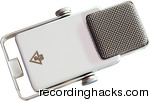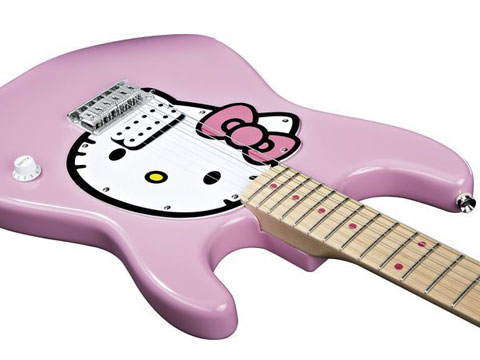
Brent Casey Interview
Wednesday, April 4th, 2012 | by matthew mcglynn
 Brent Casey is an audio equipment designer, perhaps best known — to date! — for the Studio Projects line of microphones. He joined PMI Audio (parent company to Studio Projects) around 2002, redesigned the entire Studio Projects mic line around 2006, and in 2010 released the “Little Square Mic,” or LSM, which is in large part the subject of this interview.
Brent Casey is an audio equipment designer, perhaps best known — to date! — for the Studio Projects line of microphones. He joined PMI Audio (parent company to Studio Projects) around 2002, redesigned the entire Studio Projects mic line around 2006, and in 2010 released the “Little Square Mic,” or LSM, which is in large part the subject of this interview.
Why should you care about a $179 USB microphone that is available in 4 colors, including pink?
Because no matter what color it is, it kicked a whole lot of ass in the Best $200 Condenser shootout. We’d set out to identify great “first mics,” which could double as inexpensive studio workhorses even after one’s mic locker gets built out. The LSM was one of the top picks in all three sessions — guitar & vocals, podcasting/VO, drum overheads.
(Don’t take my word for it, though; you can listen blind to the raw tracks and decide for yourself.)
Now that I’ve been recommending  LSM to people, I wanted to get a little more insight into its origins. Brent was, as is always the case, gracious in his responses. Read on for some interesting, and maybe a little frightening insider information about the gear industry, and the full story on this little square mic too.
LSM to people, I wanted to get a little more insight into its origins. Brent was, as is always the case, gracious in his responses. Read on for some interesting, and maybe a little frightening insider information about the gear industry, and the full story on this little square mic too.
I’m interested in the genesis of the LSM. What were its design goals?
 I got the original idea for a USB mic from visiting a Lake. Specifically, Cory Lake of American Guitar & Band, outside of Minneapolis. He told me two very interesting things. One was that the Hello Kitty Stratocaster is the absolute hottest selling MI product on the planet. [MI is the industry’s term for Musical Instrument products. –Ed.]
I got the original idea for a USB mic from visiting a Lake. Specifically, Cory Lake of American Guitar & Band, outside of Minneapolis. He told me two very interesting things. One was that the Hello Kitty Stratocaster is the absolute hottest selling MI product on the planet. [MI is the industry’s term for Musical Instrument products. –Ed.]
The second thing was that there was a specific customer archetype — usually a parent — who wanted a mic that plugged into a computer without a lot of hassle. In other words, a microphone for somebody who couldn’t program a VCR… and for those of you who may not have been around back then, “VCR’s” were a tape drive mechanism used for watching video.
This is the primary reason why the LSM has no switches, or undue complexity of any sort. The present circuitry actually has the capability to turn the mic into a porcupine of I/O, dials, switches, etc., but we chose not employ any of that. Anyhow, Cory asked if I had any interest in designing a USB mic and I said “no.” I did not. Then, a couple months later, I took his advice to heart and set about designing the mic.
The initial design goals I took into consideration were as follows:
- Fidelity
- Functionality
- Form
With regards to the first point, we went with an externally polarized large capsule element [see photos of the LSM capsule] with the conventional high impedance circuitry mated to the ADC [Analog-Digital Converter] to yield what I consider a good signal path.
It was a pain in the ass to go back and change a finished design…
In terms of functionality, the idea was to make a very simple mic that, while large capsule, was very rugged and able to stand freely on a surface, or be mounted on a mic stand. Of course, the functionality doubled later on with the addition of the P48 [phantom-powered analog audio] output, which was an idea put forth by a staff member of Sweetwater during a presentation I gave at their Fort Wayne facility. It was a pain in the ass to go back and change a finished design, but I’m very glad we did. This is why the mic has this split personality of being a podcast/Skype-type device as well as a serious recording mic.
The form this all took is similar in size and shape to many handheld devices we carry around with us today. I sat there with a pencil and my sketchbook and drew out ideas and eventually the concept materialized. Then, I switched to CAD, which is my version of a video game. Initially, I wanted something that folded up into an integrated body/case, but I got on the Internet, typed in “USB mics” and saw that Blue was already doing this and was really bummed. There was even room to store the cable in theirs. I bought one anyway because I thought it was cool. It was about forty bucks on Amazon back then.
When you’re faced with the task of designing a new microphone, how do you begin a circuit design? Do you just reach for a known design, borrowing from one of the classics?
None of my circuit designs are taken from existing mics, except for the  LSD2, which uses two C3 circuits.
LSD2, which uses two C3 circuits.
The process begins of course with the transducer source — the highest impedance — and moves downward from there. With regards to high impedance/low noise circuitry in capacitor-type mics, there are really only two suitable devices, tubes and JFETs. From there, it’s a matter of stages which are configured, first and foremost, to allow for optimal signal transfer. Of course, if one is not wedded to getting the absolute highest specifications across the board, there is also room to experiment with elements and configurations which may introduce some additional character into the overall result.
Also, as is the case with some of the standard transducers used in the industry, there are nonlinearities that may require a bit of control. So, in some designs, there is circuitry dedicated to shaping specific frequency ranges of the raw capsule output.
I guess the obvious example of an industry-standard capsule that has well-known nonlinearities is the one in the Neumann U87?
Yes, the capsule style used in the U87 is an example of that.
Given a standard circuit design, how much does component selection matter? For example, do the actual type of capacitors and brand of FET(s) make a difference?
Component selection always matters, but there is a magnitude to how much difference in tonality and performance that a single discrete component may impart. These small differences may be swamped by other factors like the headgrille acoustics, or overall circuit topology, for example.
A lot of people get caught up in the marketing and buzzword aspects of components to a great degree. I like to spec components that perform well, are commonly obtained and don’t cost an arm and a leg. If there’s one item on your bill of materials that costs as much as everything else combined, there better be a damn good reason for it being there.
Otherwise the market is flooded with high quality, cheap, mass-produced parts with good tolerances. That’s why mics costing several thousands of dollars may use many of the same components found in a sub-$200.00 model. There are however, certain components like very high value resistors, that may be startlingly expensive, but worth every penny for a given design. As for capacitors, anyone who’s into modding mics knows that these are the best way to turn your imported mic into a vintage wonder inside of an hour! They’re colorful and come in many shapes, sizes, dialectrics and prices. The higher the price, the better they sound. And they’re easy to swap out.
People who are so inclined should take things apart and modify them.
Of course, when it comes to things like double blind listening tests, there may not be anyone in the room who can pick out those fancy caps — but I will say that the recordist/modder may be more inspired to use that particular mic because of its magical properties and therefore obtain better results, based on the way they feel about the mic. This is a good thing to do in today’s throwaway culture anyway. People who are so inclined should take things apart and modify them. I believe this to be a real and positive effect of a much greater magnitude than what a particular component is doing on a physical level. It is crucial, however, to have an understanding of how various types of component will affect your signal path.
In terms of mechanical components like switches, potentiometers, jacks, etc. I think that a high quality component should be the default choice. With regards to high, or low-end designs, the real difference is in the tolerances of the parts. The implementation of all these various pieces and parts determines the ultimate outcome of a design.
Can you clarify your point about tolerances, and how costs affect component selection?
In terms of electronic components, a “higher tolerance” is generally determined by part selection and grading. For example, the potentiometers we use for audio gear, by and large, have a specified 20% tolerance. If you want higher tolerances, then you may be employing the exact same 20% pot, but it has been tested and determined to hold a tolerance of lesser variability than its other 20% siblings. Same part, higher tolerance. Same thing with tubes and transistors. If you want the operating points of your active devices to be within a certain range, then you test, sort and match in order to achieve a higher tolerance. Naturally, there is a direct relationship here with cost. Therefore, a high-, or a low-end design may share common components, but the difference is in the grading of a given device.
When speaking of housings, bodies, chassis, capsules, etc., I am referring to the degree of precision that we specify to our metalworkers and machinists. There is a world of difference along this spectrum and it cannot be overstated — both in quality and in cost. Here, we speak of fit, finish and feel. Not sure why “f’s” go together in threes. Have to ponder that one. Anyhow, the parts that make up a product and how they all go together contributes to the overall look and feel.
Apple’s products are an example to which most people can relate. They’ve got this stuff down cold. Of course, with a comparatively low-volume product like a boutique condenser mic, the machining costs can be pretty ridiculous, if one wants the end result to feel and look just as good as it sounds. It is not possible to make such a product cheaply.
A lower quality condenser mic may sound better than it looks. Ideally, a well-designed microphone should look, feel and sound very good, no matter the price.
And of course, the prime example of “tolerances” is the capsule itself. These are not only specialized small parts with little tiny holes made with drill bits that wear out quickly… There are microscopic dimensional tolerances that must be strictly held for unit-to-unit repeatability and to achieve the highest quality performance. This is particularly true of pressure gradient mics. [E.g., all of these. –Ed.]
If your capsule is built and assembled haphazardly, then your cardioid plot will show it. And as mentioned, the assembly of a capsule is fairly specialized. Results will always vary within any capsule production line. This is why Studio Projects microphone packaging is color coded on some models, denoting one of three sensitivity levels. The capsules are sorted according to this. For mics such as the CS series, the LSD-2 and the C4‘s, there is no color coding, because the mics use capsules that are within a specific range of sensitivity, relative to one another.
We’ve managed to do OK with the 797 Audio factory over the years. I plotted the frequency of a couple of  CS5s the other day for a particular client and the plots came out pretty much identical. It looked like the same mic from the TEF‘s point of view. I had to go back and re-do it just to make sure I wasn’t seeing things.
CS5s the other day for a particular client and the plots came out pretty much identical. It looked like the same mic from the TEF‘s point of view. I had to go back and re-do it just to make sure I wasn’t seeing things.
The LSM was built with a strict price point in mind, which suggests that there might be opportunities for owners to modify the mic — swapping in higher-grade components — to upgrade its performance. Can you suggest a starting point, maybe something you’d like to have included in the production model?
I recommend Vishay RNX series resistors in the high impedance section. You may need to shoehorn them in there, but they’re quite good and fairly affordable. As for capacitors, anything made by unicorns in a German forest on a full moon, during a leap year. But not if they have a black stripe. It must be the gold striped ones.
Is that not the perfect parting shot in an interview with a mic designer about aftermarket modifications? Oh yes. Yes it is. Now you get a sense of why I always make time to chat with Brent at trade shows.
Special thanks to Brent Casey and everyone at PMI Audio. The LSM is a winner, and I look forward to whatever comes next!
(Especially because I know some of what comes next, even if I can’t mention it here. 😉 )
Tags: Brent Casey
Posted in Interviews, Microphones, Music Business | 5 Comments »



Trevor
April 4th, 2012 at 10:59 am
I would be interested to hear your guys’ results with the USB side of this microphone. I bought one, returned it to PMI for another, and found the USB signal unusable on both due to a high pitched whine reminiscent of PhotoBooth videos people make on their Macs. PMI was “unable to reproduce” the problem but it was plain as day on multiple systems with two different mics. You guys are really pushing this mic, but I found it didn’t do half of what it was supposed to.
matthew mcglynn
April 4th, 2012 at 11:26 am
@Trevor, we never even plugged in the USB cable on the eval mic.
Through its analog interface, it sounded great, and stood out in a series of blind shootouts. These are subjective results, so I would expect you to listen and decide for yourself.
If we get an opportunity to test it as a USB mic, we’ll do so.
Steve Faul
April 5th, 2012 at 1:52 am
Interesting interview. Casey seems like a true microphone guru who loves his job. Thanks for posting.
We use USB mics at our TV station as an economical solution in our news edit booths. A mic that can be used in both a USB and an analog connection could be useful in our business.
In my limited experience it seems the USB connection raises the noise floor of any USB mic. I don’t know the exact cause of noisy USB ports, but I did once blow about a half-hour of studio time searching for noise in my DAW only to discover it went away when I removed a flash drive. And we’ve a fair share of issues caused by dongles. Maybe USB hardware is the weak link.
Per Ladegard
April 5th, 2012 at 7:07 am
Trevor, RE high pitched whine:
My wife bought a Samson USB microphone, Sound on Sound Magazine tested this mic on 3 different Macs, it whined on two of them, not the third. I tested my wife’s mic on my Mac, it whined like crazy. Then I read on a forum that the problem could be a poorly shielded USB cable. So I did something hopelessly unscientific, I bought a better cable and gave it back to my wife. No whine (from the mic!). Her Mac or the new cable? Can’t be bothered to find out, but a well shielded good cable costs next to nothing so give it a try. Or you could buy four new Macs and hope for the best.
SANDEEP G
August 20th, 2015 at 10:20 pm
Hi
Could i get the personal email.id of Mr Brent Casey who has designed LSM.
Regards
Sandeep